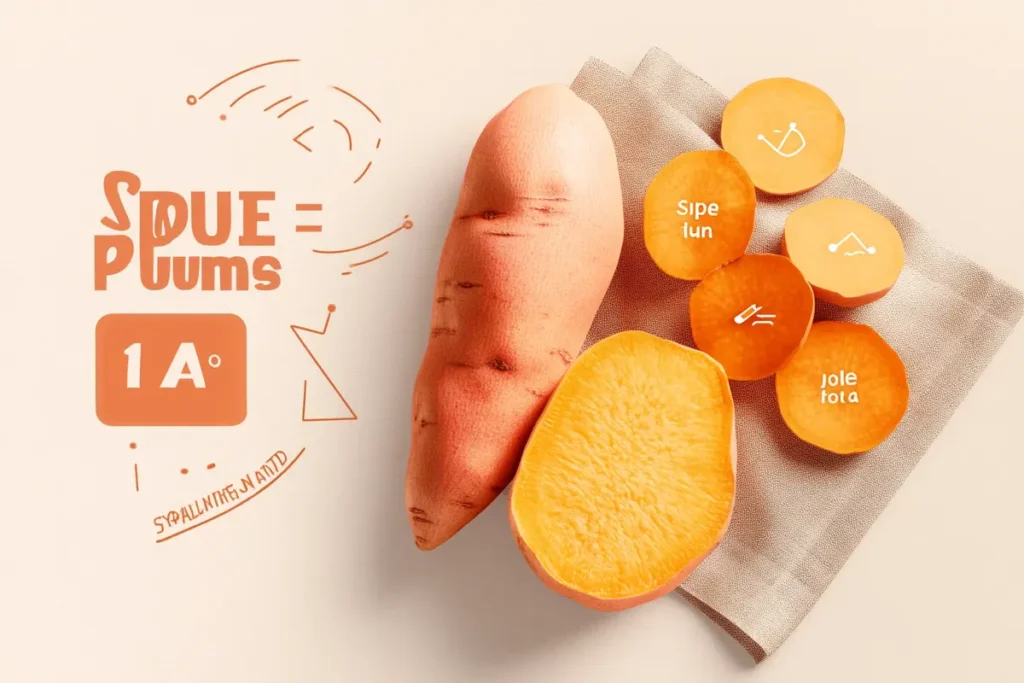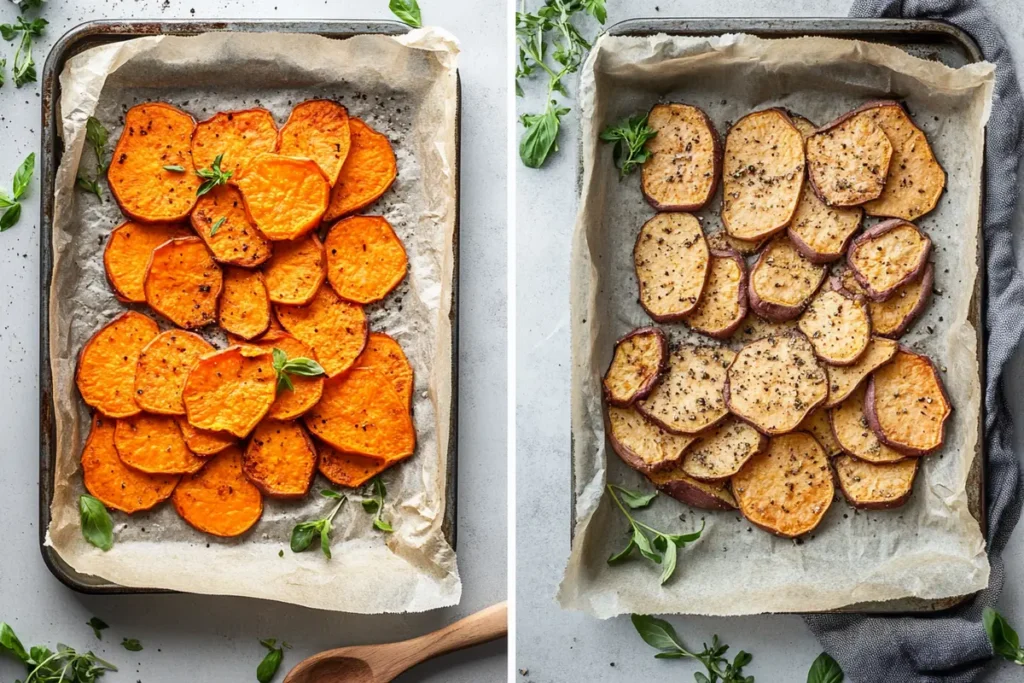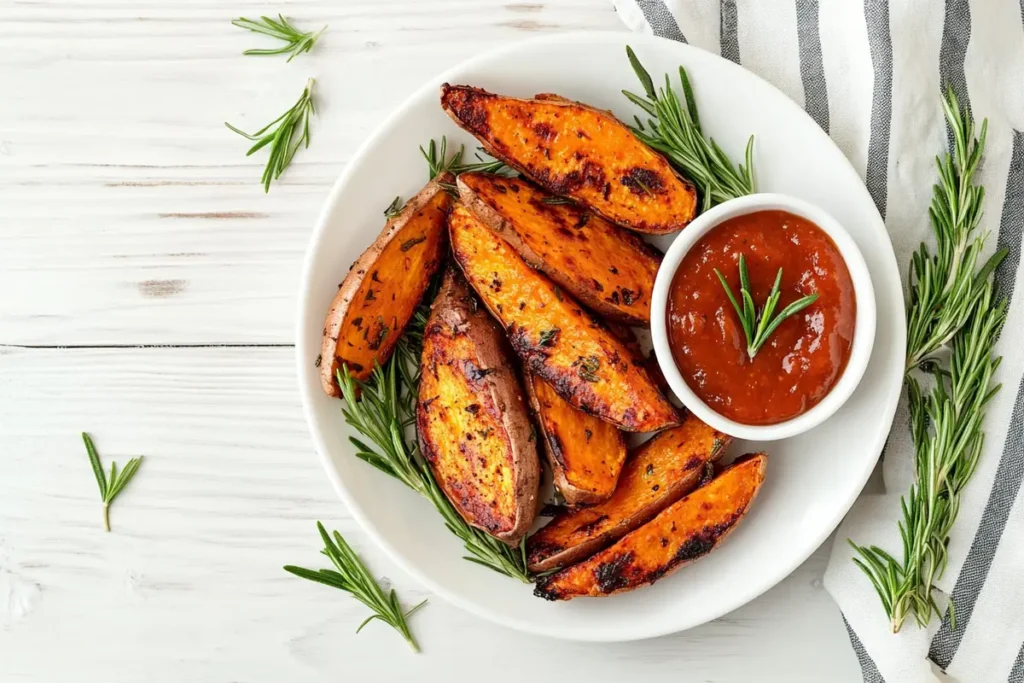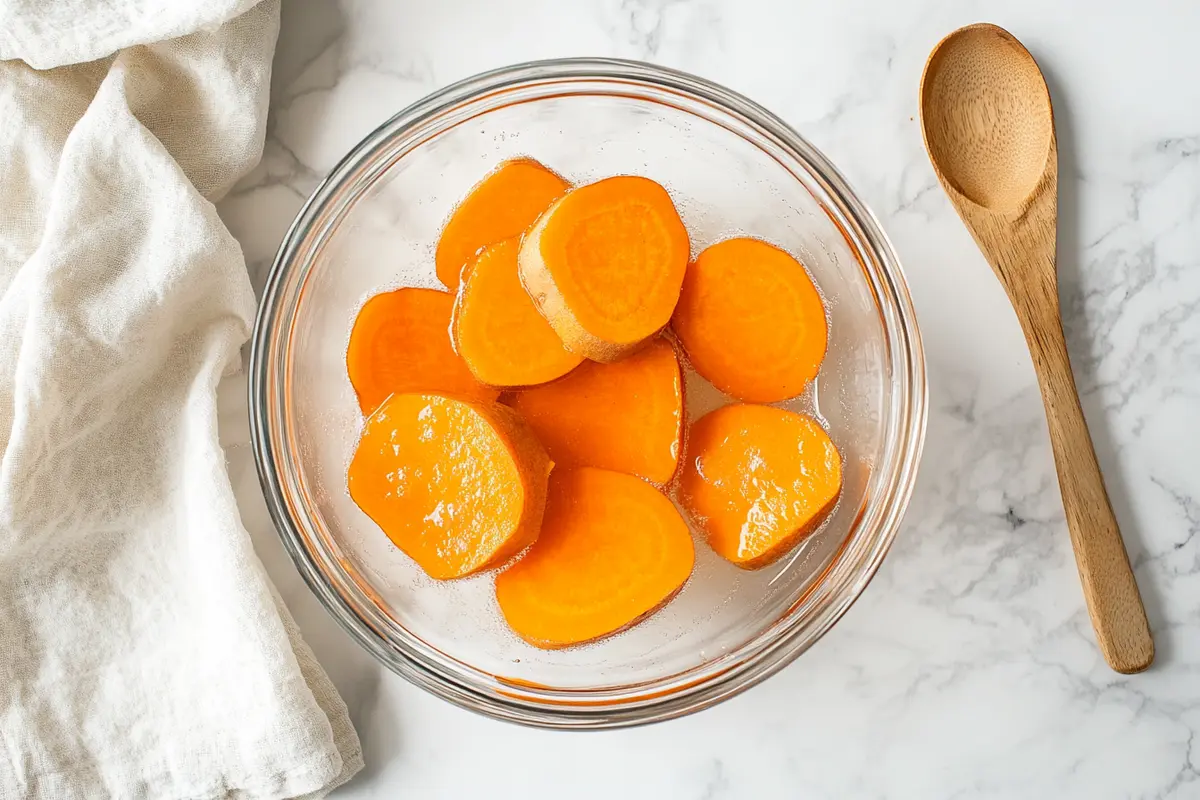Introduction to Soaking Sweet Potatoes
Why do you soak sweet potatoes before baking? Soaking sweet potatoes before baking is a method that might seem unnecessary at first glance, but it carries some surprisingly rewarding benefits. When you soak sliced or chopped sweet potatoes, you’re not just softening the vegetable you’re setting the stage for a tastier, more satisfying result. This practice stems from a basic kitchen principle: starch reduction. Sweet potatoes are naturally rich in starch, which affects both their texture and how they caramelize during baking.
If you’ve ever wondered why some sweet potatoes come out soft and creamy while others remain dense or fail to crisp up, it often comes down to how much starch remains inside the slices. Let’s start by unraveling what happens inside a sweet potato and why a quick soak can be the secret to better baking.
Understanding Sweet Potatoes
Sweet potatoes are more than just a colorful addition to your dinner plate—they’re packed with nutrients and unique properties that influence how they cook. To appreciate why soaking is so effective, we need to first understand the natural composition of sweet potatoes and how their starch content plays a key role.
Nutritional Profile of Sweet Potatoes

Sweet potatoes are loaded with beneficial nutrients that make them a popular choice for health-conscious eaters. They’re rich in vitamin A, fiber, potassium, and antioxidants. Here’s a quick breakdown of their nutritional benefits:
- Beta-carotene: This gives sweet potatoes their vibrant orange hue and supports immune health.
- Dietary fiber: Helps with digestion and creates that satisfying, full feeling.
- Complex carbohydrates: Sweet potatoes contain slow-digesting carbs, making them ideal for steady energy levels—perfect for pairing with foods that provide comfort and warmth.
Nutritional Content of Sweet Potatoes (Per 100g)
| Nutrient | Amount per 100g |
|---|---|
| Calories | 86 kcal |
| Carbohydrates | 20.1 g |
| Fiber | 3.0 g |
| Sugars | 4.2 g |
| Protein | 1.6 g |
| Fat | 0.1 g |
| Vitamin A (Beta-carotene) | 14187 IU (283% DV) |
| Potassium | 337 mg |
| Vitamin C | 2.4 mg |
| Calcium | 30 mg |
However, with these benefits comes a high starch content, which brings us to the next point.
The Role of Starch in Sweet Potatoes
Sweet potatoes are starchy root vegetables, and their natural starch content can affect the way they cook. Starch molecules absorb water and expand when heated, which influences the texture of the potato.
- Unsoaked sweet potatoes: Tend to bake unevenly, with some pieces turning mushy while others remain firm.
- Soaked sweet potatoes: Release some of their excess starch, resulting in a more consistent, tender texture throughout.
This is because soaking draws out some of the surface starch, making it easier for heat to penetrate evenly. In addition, when there’s less starch clinging to the outside, you’ll get a crispier exterior—a must for perfectly roasted or baked sweet potatoes!
In the next section, we’ll take a closer look at the science behind this transformation and explain why this soaking step makes such a noticeable difference when baking.
The Science Behind Soaking Sweet Potatoes
Understanding the science of why soaking sweet potatoes works can help you get the best results in your baking routine. This step isn’t just about softening the sweet potatoes—it’s about improving their texture, flavor, and even how quickly they cook. Let’s break down what’s happening at a molecular level.
How Soaking Affects Starch Content

Sweet potatoes are packed with amylose and amylopectin, two types of starch molecules. When sweet potatoes are soaked, particularly in cold water, some of these starch molecules are drawn out into the water. Here’s why that matters:
- Reduced surface starch: Helps sweet potatoes bake without sticking together.
- Better caramelization: Less starch allows the natural sugars in sweet potatoes to brown more easily during baking.
- Crispier edges: By washing off some of the starch, you reduce the gummy, sticky layer that prevents a golden, crispy exterior.
Fun fact: This is the same principle used when soaking potatoes for fries!
Impact on Texture and Flavor
Soaking sweet potatoes affects not only their texture but also their taste. When too much starch remains, it can create a dense, gluey texture that overpowers the natural sweetness of the vegetable.
- With soaking: Sweet potatoes become light, tender, and subtly sweet.
- Without soaking: The texture may remain dense and uneven, especially if you’re baking larger pieces.
In addition to drawing out starch, soaking can help sweet potatoes absorb a bit of water, which keeps them from drying out in the oven. This can enhance their creamy interior while maintaining a crisp, golden outer layer.
Influence on Cooking Time
Interestingly, soaking also helps sweet potatoes bake more efficiently. By reducing the starch content, the internal fibers of the sweet potato soften more quickly during the baking process.
- Soaked sweet potatoes: Bake faster and more evenly.
- Unsoaked sweet potatoes: May require more time and can bake unevenly, especially if you’re dealing with thick slices.
This step becomes particularly helpful if you’re short on time but still want that perfect balance of soft interiors and crispy edges.
By now, it’s clear that soaking sweet potatoes isn’t just a kitchen hack—it’s a scientific strategy that can improve the overall baking experience. But how long should you soak them? And are there any pitfalls to avoid? In the next section, we’ll walk through the practical steps and answer these questions in detail.
Practical Guide to Soaking Sweet Potatoes
Now that you know why soaking sweet potatoes before baking is so beneficial, it’s time to get into the nitty-gritty of how to do it right. In this section, we’ll cover a step-by-step process, the recommended soaking duration, and some common mistakes to avoid so you can get consistently delicious results.
Step-by-Step Soaking Process

Follow these simple steps to soak your sweet potatoes properly and prepare them for baking success:
- Peel and cut:
- Peel the sweet potatoes (if desired) and slice them into your preferred size—wedges, cubes, or fries.
- Prepare a soaking bowl:
- Fill a large bowl with cold water. Cold water is key here, as it helps to draw out starch without beginning to cook the potatoes.
- Submerge the sweet potatoes:
- Place the sweet potato pieces in the bowl and ensure they’re fully submerged. You can place a plate over them if they float.
- Let them soak:
- Soak for the recommended amount of time (we’ll get to that next).
- Drain and pat dry:
- After soaking, drain the water and pat the sweet potatoes dry with a clean kitchen towel—an essential step if you’re aiming for smooth, creamy sides.or paper towels. Removing excess moisture is crucial for achieving crispy baked potatoes.
Recommended Soaking Duration
The length of time you soak your sweet potatoes can affect the outcome:
- 15–30 minutes: Removes enough starch for most baking needs and improves texture without making the sweet potatoes overly soft.
- Up to 1 hour: Ideal for very crispy baked sweet potatoes, especially if you’re cutting them into fries.
- Overnight soak: While this can be done, it’s typically unnecessary unless you’re prepping ahead of time. Just make sure the water stays cold and that you refrigerate the bowl to avoid any spoilage.
Soaking for too long can cause the sweet potatoes to absorb too much water, potentially diluting their flavor and affecting their natural sweetness.
Common Mistakes to Avoid
To get the best results, avoid these common soaking missteps:
- Skipping the drying step: Wet sweet potatoes don’t crisp up in the oven, so be sure to dry them thoroughly after soaking.
- Using hot water: This can start the cooking process prematurely and result in soggy potatoes.
- Soaking too long: If left too long, sweet potatoes can become waterlogged, losing both flavor and texture.
By mastering these steps, you’ll have sweet potatoes that are perfectly prepped for baking crispy on the outside, tender on the inside, and packed with flavor.
Frequently Asked Questions (FAQs)
To address some of the most common queries about soaking sweet potatoes before baking, here’s a handy FAQ section with detailed answers to help you master this technique.
Is it necessary to soak sweet potatoes before baking?
While not mandatory, soaking sweet potatoes can make a significant difference in their texture. By reducing surface starch, you achieve a crispier exterior and a creamier interior—especially if you’re making fries or roasted cubes. If you prefer a soft, mash-like texture, soaking may not be necessary.
How long should I soak sweet potatoes for optimal results?
A soak time of 15 to 30 minutes in cold water is generally enough to remove excess starch. For even crispier results, you can soak them for up to an hour. However, avoid soaking for longer than 24 hours to prevent them from becoming waterlogged.
Does soaking sweet potatoes remove nutrients?
Some water-soluble nutrients, such as vitamin C and certain B vitamins, may leach into the water during soaking. However, sweet potatoes are rich in nutrients, so this minimal loss is unlikely to affect their overall nutritional value significantly.
Can I soak sweet potatoes overnight?
Yes, you can soak sweet potatoes overnight, especially if you’re prepping in advance. Just be sure to store the bowl of water in the refrigerator to keep the sweet potatoes fresh and safe from bacteria growth. However, for optimal results, shorter soaks of 1 hour or less are typically sufficient.
Should I soak sweet potatoes in cold or warm water?
Cold water is the best option for soaking sweet potatoes. Warm or hot water can partially cook the sweet potatoes, affecting their texture and potentially making them mushy rather than crispy after baking.
Does soaking affect the glycemic index of sweet potatoes?
Yes, soaking sweet potatoes can have a slight effect on their glycemic index by reducing their starch content. This means the sweet potatoes may cause a slower rise in blood sugar levels compared to unsoaked ones. However, this effect is generally mild and may vary depending on the length of soaking and how the potatoes are cooked.
Conclusion
Soaking sweet potatoes before baking may seem like a small step, but it can yield big results. By drawing out excess starch, you’re ensuring that your sweet potatoes bake evenly, crisp up beautifully on the outside, and stay tender on the inside. Whether you’re preparing fries, wedges, or roasted cubes, this simple method helps enhance both texture and flavor.
Remember, soaking for 15 to 30 minutes in cold water is usually sufficient to achieve noticeable improvements. Just don’t forget to dry them thoroughly before baking to avoid excess moisture. By following these tips, your sweet potato dishes will come out perfectly every time—crispy, flavorful, and packed with natural sweetness, whether you’re making fries or a sweet potato cheesecake.we all love.
So, the next time you’re ready to bake, give your sweet potatoes a quick soak. It’s a small but powerful trick that can take your cooking from good to extraordinary!

